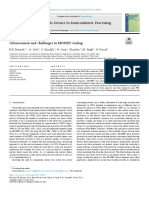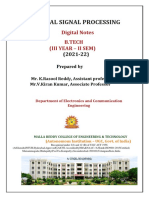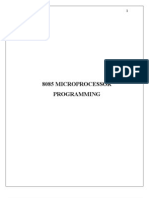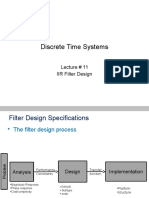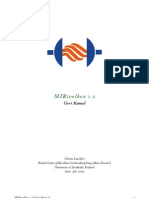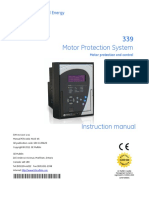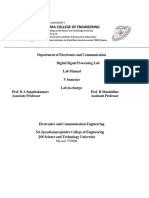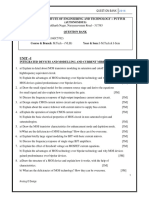Introduction To DSP
Introduction To DSP
Uploaded by
api-247714257Copyright:
Available Formats
Introduction To DSP
Introduction To DSP
Uploaded by
api-247714257Original Title
Copyright
Available Formats
Share this document
Did you find this document useful?
Is this content inappropriate?
Copyright:
Available Formats
Introduction To DSP
Introduction To DSP
Uploaded by
api-247714257Copyright:
Available Formats
Engr.
Hinesh Kumar
Lecturer, I.B.T, LUMHS
Signal
Signal Classification
Signal Processing
Concept of Systems
DSP
Elements of DSP
Advantages of DSP
Limitations
Applications
A word Signal comes from latin Signum which
means Sign.
A signal is a quantity or effect such as current or
voltage that can be varied in such a way as to
convey information. OR
A signal is defined as a mathematical function that
conveys information about the state or behavior of a
physical system.
Examples: electrical current, voltage, force,
speed, speech, music, picture and video signals
etc
Analog Digital VS
Time Continuous Discrete
Amplitude Continuous Discrete
An analog or analogue signal is any continuous
signal for which the time varying feature.
An analog signal is a signal that exists at every
instant of time
A continuous signal is often referred to as
continuous time or analog.
The independent variable is a continuous variable
Continuous signal can assume any value over a
continuous range of numbers
It is a special form of discrete time signal
which is discrete in time and amplitude.
A digital signal is acquired by representing the
sampled analog value into a finite set of values
(quantization).
These signals are called digital because the
samples are represented by digits.
Computer, Semiconduct and Information Science
1960s-1970s
Representation, transformation and manipulation
of signals and the information they contain.
Signal operation include:
(1) Transform, filter, inspection, spectrum analysis;
(2) Modulation and coding;
(3) Analog Signal Processing;
(4) Digital Signal Processing.
System
Device or technology of signal processing
Analog System
System with analog input and output.
Digital System
System with digital input and output.
Acoustic
domain
Electric
domain
Acoustic
domain
Continuous-time system: the input and output signals
are continuous time
Acoustic
domain
Acoustic
domain
Electric
domain
Digital domain
Discrete-time system has discrete-time input and output
signals
Acoustic
domain
Electrical
domain
Electrical
domain
Acoustic
domain
Digital
domain
a bit loud
Analog Computer
Digital Computer
ADC
DSP
DAC OUTPUT
1010 1001
a bit loud
Converting a continuously changing waveform (analog)
into a series of discrete levels (digital).
The analog waveform is sliced into equal segments and
the waveform amplitude is measured in the middle of
each segment
The collection of measurements make up the digital
representation of the waveform
A basic DSP system is composed of:
An ADC providing digital samples of an analog input
A Digital Processing system
A DAC converting processed samples to analog
output
Real-time signal processing: All processing operation
must be complete between two consecutive samples
Sensor
ADC
Analog Signal
Conditioning
Digital Signal
Conditioning
DSP DAC
Analog Signal Processing
Digital Signal Processing
1. An analog input
2. An analog filter,
3. An analog-to-digital conversion (ADC) unit,
4. A digital signal (DS) processor,
5. A digital-to-analog conversion (DAC) unit,
6. and a reconstruction (anti-image) filter.
The analog input signal, which is continuous in
time and amplitude.
It is the signal generated from some transducer
or some communication system.
Examples of such analog signals include current,
voltage, temperature, pressure.
It may be biomedical signal like ECG or EEG.
Generally it is analog in nature. It is denoted by
x(t).
This is basically a low pass filter.
It is used for the following purposes.
It removes the high frequency noise contained
in input signal.
As the name indicates, it avoids aliasing effect.
That means it is used to band limit the signal.
The band-limited signal at the output of the
analog filter is then sampled and converted
into the digital signal, which is discrete both
in time and in amplitude.
This is required because digital signal
processor accepts the signal which is digital
in nature.
It processes input signal digitally.
In a simple language processing of input signal
means modifying the signal as per requirement.
It consists of lowpass, highpass, and bandpass
digital filtering, or other algorithms for different
applications.
DS processor is a special type of digital computer
consists of , a microprocessor, or an advanced
microcontroller; and can be implemented using
software in general.
The DAC unit, converts the output of the digital
signal processor into an analog output signal.
The signal is continuous in time and discrete in
amplitude.
Output signal of DAC is an analog, that means it
is a continuous signal.
It may contain high frequency components which
are unwanted.
To remove these components, reconstruction
filter is used.
1. Versatility
Digital systems can be reprogrammed for
multiple applications ( where programmable DSP
chips are used). Moreover, digital systems can be
ported to different hardware
2. Repeatability
Digital systems can be easily duplicated.
These systems do not depend upon component
tolerances and temperature.
3. Simplicity:
It is easy to built any digital system as
compared to an analog one.
4. Accuracy:
To design an analog system, analog
components like resistors, capacitors and inductors
are used.
The tolerance of these components reduce
accuracy of the system.
While in case of DSP; much better accuracy is
obtained.
5. Remote Processing
Analog signals are difficult to store because
of problems like noise and distortion.
While digital signal can be easily stored on storage
media like magnetic tapes, disks etc.
Thus as compared to analog signals digital signals
can be easily transposed.
So remote processing of digital signal can be done
easily.
6. Implementation of algorithms:
The mathematical processing algorithms can
be easily implemented in case of digital signal
processing.
But such algorithms are difficult to implement in
case of analog signals.
7. Easy Up gradations:
Because of the use of software, digital signal
processing systems can be easily upgraded as
compared to analog systems.
8. Compatibility:
In case of digital systems, generally all
applications needs standard hardware.
Thus operation of DSP system is mainly
dependent on software.
Hence universal compatibility is possible as
compared to analog systems.
9. Cheaper:
In many applications, the digital systems are
comparatively cheaper than analog systems.
1. System Complexity:
DSP system needs use of converters like
ADC and DAC.
This increases the system complexity compared to
analog systems. Similarly in many applications, the
time required for this conversion is more.
Bandwidth Limitation:
In case of DSP system, if input signal is
having wide bandwidth then it demands for high
speed ADC.
This is because to avoid aliasing effect, the
sampling rate should be at least twice the
bandwidth.
Thus such signals require fast digital signal
processors. But always there is practical limitation
in the speed of processors and ADC.
3. Power Consumption:
A typical digital signal processing chip
contains more than four lakh transistors.
Thus power dissipation is more in DSP systems as
compared to analog systems
4. For small applications digital signal processing
systems are expensive as compared to analog
systems
IMAGE PROCESSING
Pattern recognition
Robotic vision
Image enhancement
Satellite weather map
animation
INSTRUMENTATION & CONTROL
Spectrum analysis
Position and rate control
Noise reduction
Data compression
SPEECH & AUDIO
Speech recognition
Speech synthesis
Text to speech
digital audio
MILITARY
Secure communication
Radar processing
Sonar processing
Missile guidance
TELECOMMUNICATION
Echo cancellation
Adaptive equalization
Video conferencing
data communication Biomedical
Patient monitoring
Scanners
ECG (Electrocardiograph)
X-ray storage/enhancement
Consumer applications
digital, cellar mobile phones
universal mobile telecommunication system
digital television
digital camera
internet music, phones and video
digital answer machines, fax and modems
voice mail system
interactive entertainment systems
You might also like
- Advancement and Challenges in MOSFET ScalingDocument17 pagesAdvancement and Challenges in MOSFET ScalingRajatNo ratings yet
- Study of Various ADCs and Compare Their Performance and ParametersDocument12 pagesStudy of Various ADCs and Compare Their Performance and ParametersijaertNo ratings yet
- Optimum Array Processing: Part IV of Detection, Estimation, and Modulation TheoryFrom EverandOptimum Array Processing: Part IV of Detection, Estimation, and Modulation TheoryNo ratings yet
- RF Analog Impairments Modeling for Communication Systems Simulation: Application to OFDM-based TransceiversFrom EverandRF Analog Impairments Modeling for Communication Systems Simulation: Application to OFDM-based TransceiversNo ratings yet
- Integrated Circuits: Harpreet Singh 100806043Document35 pagesIntegrated Circuits: Harpreet Singh 100806043Varinder Singh MaanNo ratings yet
- Integrated CircuitsDocument43 pagesIntegrated Circuitsgovardhan50No ratings yet
- Basics of Digital FiltersDocument67 pagesBasics of Digital FiltersHogo GohNo ratings yet
- Vlsi Tech QBDocument5 pagesVlsi Tech QBanupvasuNo ratings yet
- DSPDocument19 pagesDSPگيدوڙو ماڇي0% (3)
- Seminar Report On Integrated Services Digital Network (ISDN)Document26 pagesSeminar Report On Integrated Services Digital Network (ISDN)pepgutsy100% (1)
- Vlsi Mtech Jntu Kakinada SyllabusDocument11 pagesVlsi Mtech Jntu Kakinada Syllabusaditya414No ratings yet
- Digital Signal ProcessingDocument163 pagesDigital Signal ProcessingMaster RajuNo ratings yet
- Electrical and Electronic Measuring InstrumentsDocument27 pagesElectrical and Electronic Measuring InstrumentsSaswat NayakNo ratings yet
- Unit6dspprocessor 140207205522 Phpapp02Document34 pagesUnit6dspprocessor 140207205522 Phpapp02Arun Kumar SNo ratings yet
- Finite Word Length EffectsDocument9 pagesFinite Word Length Effectsohmshankar100% (2)
- Black BookDocument86 pagesBlack BookPradeep RajputNo ratings yet
- Spread SpectrumDocument41 pagesSpread Spectrummohan inumarthiNo ratings yet
- DSP Book by NagoorkaniDocument11 pagesDSP Book by Nagoorkanigeetha657595No ratings yet
- Advanced Digital Signal Processing With Matlab (R)Document4 pagesAdvanced Digital Signal Processing With Matlab (R)srinivaskaredlaNo ratings yet
- Ultrasonic Radar EAISDocument14 pagesUltrasonic Radar EAISSiddharth maneNo ratings yet
- Linear Integrated Circuits - Lecture Notes, Study Material and Important Questions, AnswersDocument10 pagesLinear Integrated Circuits - Lecture Notes, Study Material and Important Questions, AnswersM.V. TVNo ratings yet
- MPMC Lab Manual To PrintDocument138 pagesMPMC Lab Manual To PrintKasthuri SelvamNo ratings yet
- Ear Biometric SystemDocument20 pagesEar Biometric SystemAriel CarrascoNo ratings yet
- Noise: Optical Communication Lecture NotesDocument20 pagesNoise: Optical Communication Lecture NotesrazifhamzahNo ratings yet
- JNTUA Signals and Systems Notes - R20Document106 pagesJNTUA Signals and Systems Notes - R20chowdarychinnu457No ratings yet
- Digital Signal ProcessingDocument2 pagesDigital Signal ProcessingAnonymous HyOfbJ60% (1)
- Analog Circuits K-NotesDocument42 pagesAnalog Circuits K-NotesNitin TembhurnikarNo ratings yet
- Advanced Digital Signal Processing Part 4: Digital Filters: Gerhard SchmidtDocument145 pagesAdvanced Digital Signal Processing Part 4: Digital Filters: Gerhard SchmidtDeeraj RajkarnikarNo ratings yet
- EET207 Signals & Systems Assignment 1Document14 pagesEET207 Signals & Systems Assignment 1Lee Boon HongNo ratings yet
- MatlabDocument37 pagesMatlabviniroxNo ratings yet
- ECE4007 Information-Theory-And-Coding ETH 1 AC40Document3 pagesECE4007 Information-Theory-And-Coding ETH 1 AC40harshitNo ratings yet
- Antenna and Wave Propagations PDFDocument150 pagesAntenna and Wave Propagations PDFDamini0% (1)
- Spectral Estimation NotesDocument6 pagesSpectral Estimation NotesSantanu Ghorai100% (1)
- Digital Communication Systems in Bandlimited Channel: MET 1413 Faculty of Electrical Enginerring 81310 UTM SkudaiDocument6 pagesDigital Communication Systems in Bandlimited Channel: MET 1413 Faculty of Electrical Enginerring 81310 UTM Skudaielhenshire_hNo ratings yet
- Hollow Core Optical FibersDocument184 pagesHollow Core Optical FibersDuy TùngNo ratings yet
- CourceMeterials MTECHEC13Document200 pagesCourceMeterials MTECHEC13Ramanathan SunderNo ratings yet
- Vlsi PDFDocument81 pagesVlsi PDFShruthiNo ratings yet
- Digital Integrated Circuits: A Design PerspectiveDocument78 pagesDigital Integrated Circuits: A Design Perspectiveapi-127299018No ratings yet
- Laser MetrologyDocument41 pagesLaser MetrologyjennybunnyomgNo ratings yet
- DSP Lect 11 Iir DesignDocument50 pagesDSP Lect 11 Iir DesignSayyeda UmbereenNo ratings yet
- SS Signals and Systems PRESENTATIONDocument212 pagesSS Signals and Systems PRESENTATIONARAVIND100% (2)
- JNTUK M.Tech R13 CNC SyllabusDocument18 pagesJNTUK M.Tech R13 CNC Syllabuschakri474No ratings yet
- LDICA 10M QuestionsDocument2 pagesLDICA 10M Questionsdeepa reddyNo ratings yet
- Designing A Lock-In Amplifier With Analog To Digital ConversionDocument27 pagesDesigning A Lock-In Amplifier With Analog To Digital Conversionessi12345No ratings yet
- Ec6511 DSP Lab ManualDocument156 pagesEc6511 DSP Lab Manualramadossapece100% (5)
- Chapter 1 Introduction To Robotics PDFDocument10 pagesChapter 1 Introduction To Robotics PDFOmar AL JabaiNo ratings yet
- IOT Unit3 Web Comm ProtocolsDocument31 pagesIOT Unit3 Web Comm ProtocolsSaumitra PandeyNo ratings yet
- Signals & Systems Course Contents of ElDocument2 pagesSignals & Systems Course Contents of ElNoor SabaNo ratings yet
- Experiment 6 Implementation of LP Fir Filter For A Given SequenceDocument25 pagesExperiment 6 Implementation of LP Fir Filter For A Given SequenceSrinivas SamalNo ratings yet
- EE3001 - Advanced Measurements: Digital FiltersDocument38 pagesEE3001 - Advanced Measurements: Digital Filterssiamae100% (1)
- Graphic Processing UnitDocument20 pagesGraphic Processing UnitPrashant Barve100% (1)
- 1 Digital Signal Processing - IntroductionDocument19 pages1 Digital Signal Processing - IntroductionArifiana Satya NastitiNo ratings yet
- Types of NON-COCHANNEL INTERFERENCEDocument1 pageTypes of NON-COCHANNEL INTERFERENCEroyfadliNo ratings yet
- GSM - Architecture, Protocols and ServicesFrom EverandGSM - Architecture, Protocols and ServicesRating: 1 out of 5 stars1/5 (1)
- Distributed Control of Robotic Networks: A Mathematical Approach to Motion Coordination AlgorithmsFrom EverandDistributed Control of Robotic Networks: A Mathematical Approach to Motion Coordination AlgorithmsRating: 5 out of 5 stars5/5 (1)
- Emerging Technologies in Information and Communications TechnologyFrom EverandEmerging Technologies in Information and Communications TechnologyNo ratings yet
- Microstrip and Printed Antennas: New Trends, Techniques and ApplicationsFrom EverandMicrostrip and Printed Antennas: New Trends, Techniques and ApplicationsDebatosh GuhaRating: 4 out of 5 stars4/5 (1)
- 18ecc204j - DSP - Week 1Document57 pages18ecc204j - DSP - Week 1Ankur JhaNo ratings yet
- Data ProcessingDocument15 pagesData Processingapi-247714257No ratings yet
- Lecture 3 ManagementDocument15 pagesLecture 3 Managementapi-247714257No ratings yet
- Introduction To Medical Informatics and Its ComponentsDocument18 pagesIntroduction To Medical Informatics and Its Componentsapi-247714257No ratings yet
- Chapter 1Document16 pagesChapter 1api-247714257No ratings yet
- Lec3 4Document35 pagesLec3 4api-247714257No ratings yet
- Lec7 8Document27 pagesLec7 8api-247714257No ratings yet
- Lec1 P&ao 12bmeDocument20 pagesLec1 P&ao 12bmeapi-247714257No ratings yet
- Introduction To Social SciencesDocument26 pagesIntroduction To Social Sciencesapi-2477142570% (1)
- Lec 07Document25 pagesLec 07api-247714257No ratings yet
- Lab 4 MsDocument1 pageLab 4 Msapi-247714257No ratings yet
- Lab 5 MsDocument2 pagesLab 5 Msapi-247714257No ratings yet
- Besal-2014 FormDocument1 pageBesal-2014 Formapi-247714257No ratings yet
- Competitions Rules FinalDocument8 pagesCompetitions Rules Finalapi-247714257No ratings yet
- Lec 45Document73 pagesLec 45api-247714257No ratings yet
- Unit - Iii Signal Transmission Through Linear SystemsDocument3 pagesUnit - Iii Signal Transmission Through Linear SystemsShilpa BommalaNo ratings yet
- MIRtoolbox User's Manual 1.2Document162 pagesMIRtoolbox User's Manual 1.2Olivier LartillotNo ratings yet
- Audio VU MeterDocument3 pagesAudio VU MeterkutayNo ratings yet
- ADCsurvey Rev20170801Document73 pagesADCsurvey Rev20170801Sajeendran Saji B SNo ratings yet
- Signal Processing and Filter Design Using ScilabDocument69 pagesSignal Processing and Filter Design Using ScilabManas Das0% (2)
- Unit II DAS & Signal CommunicationDocument65 pagesUnit II DAS & Signal CommunicationHOD MechanicalNo ratings yet
- Oversampling ADC: Advanced Analog IC Design Oversampling ADC Professor Y. Chiu ECE 581 Fall 2009Document24 pagesOversampling ADC: Advanced Analog IC Design Oversampling ADC Professor Y. Chiu ECE 581 Fall 2009skshawnNo ratings yet
- Mtouch™ Sensing Solution Acquisition Methods Capacitive Voltage DividerDocument28 pagesMtouch™ Sensing Solution Acquisition Methods Capacitive Voltage DividermhemaraNo ratings yet
- An Overview of FMCW Systems in MATLAB: ArticleDocument8 pagesAn Overview of FMCW Systems in MATLAB: ArticleSummer KoNo ratings yet
- Multilin 339 PDFDocument312 pagesMultilin 339 PDFDANIEL3991No ratings yet
- Evaluation Engineering Special Report - OscilloscopesDocument6 pagesEvaluation Engineering Special Report - Oscilloscopesmadhu_gNo ratings yet
- PCM CodigoDocument14 pagesPCM CodigoLeux GuillenNo ratings yet
- sIR-20 05Document2 pagessIR-20 05iwanNo ratings yet
- Baeam Forming MatlabDocument32 pagesBaeam Forming Matlabvinayak341No ratings yet
- A Simple Digital Power-Factor CorrectionDocument11 pagesA Simple Digital Power-Factor CorrectionVinoth KumarNo ratings yet
- Engineering ChemistryDocument54 pagesEngineering ChemistrysanjuNo ratings yet
- Matrox Mojito MAX DatasheetDocument7 pagesMatrox Mojito MAX DatasheetJackSteakleyNo ratings yet
- DSP LAB MANUAL Jan 2018 Final Print PDFDocument81 pagesDSP LAB MANUAL Jan 2018 Final Print PDFAafaq WaniNo ratings yet
- A Method For ADC Error Testing and Its Compensation in Ratiometric MeasurementsDocument4 pagesA Method For ADC Error Testing and Its Compensation in Ratiometric MeasurementsPreejit PrakashNo ratings yet
- MCQ Comm-2Document18 pagesMCQ Comm-2shwet_vNo ratings yet
- Digital TD Controller: For NEXO PS Series Cabinets and LS SubsDocument2 pagesDigital TD Controller: For NEXO PS Series Cabinets and LS SubsrummanhzNo ratings yet
- Analizador FFT HP3852ADocument32 pagesAnalizador FFT HP3852ACristian SpinelliNo ratings yet
- 22ec403 - Unit IiiDocument62 pages22ec403 - Unit Iii22104136No ratings yet
- Boonton's RF Peak Power Meter 4540 Series: 4541 & 4542 Power MetersDocument8 pagesBoonton's RF Peak Power Meter 4540 Series: 4541 & 4542 Power MetersAimil Ltd.No ratings yet
- Inderscience JORNAL101Document17 pagesInderscience JORNAL101Chandra Sekhar MishraNo ratings yet
- DSP Lab Manual 2021 22Document66 pagesDSP Lab Manual 2021 22Ahmed AleesaNo ratings yet
- 265 - DCCN Lecture NotesDocument132 pages265 - DCCN Lecture NotesRahul Kumar100% (1)
- 199568.speaker Recognition Method Combining FFT Wavelet Functions and Neural NetworksDocument4 pages199568.speaker Recognition Method Combining FFT Wavelet Functions and Neural NetworksKim Quy TrầnNo ratings yet
- P50 Agile P154: Technical ManualDocument286 pagesP50 Agile P154: Technical ManualJanoshNo ratings yet
- 16ec5702 AicdDocument6 pages16ec5702 AicdRuccaiyatasleemaNo ratings yet
